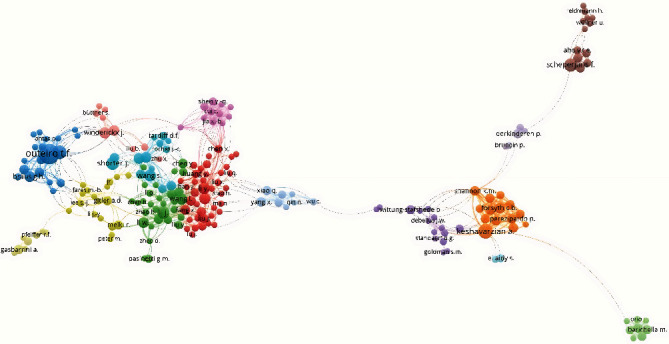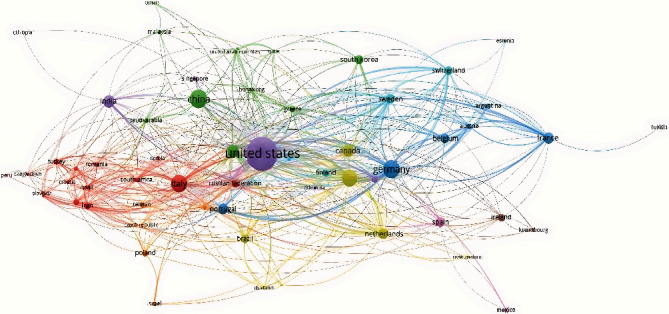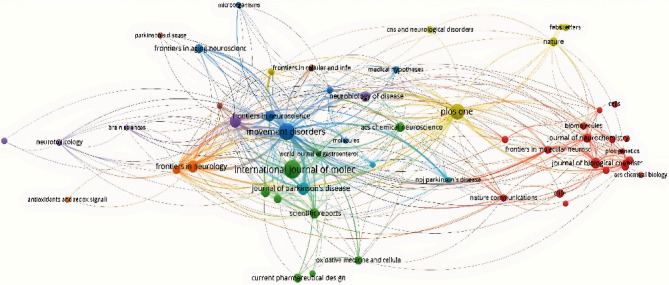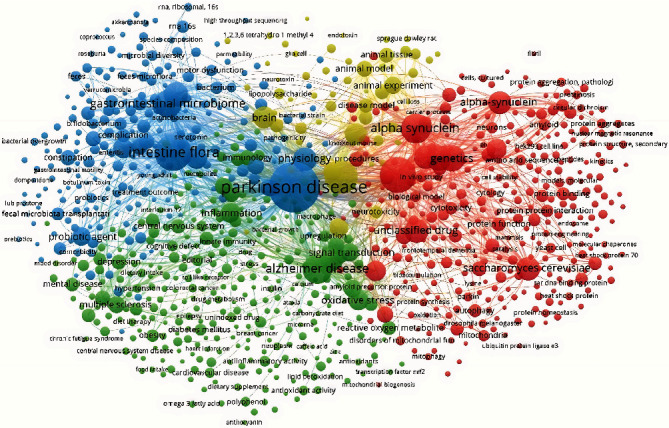Abstract
Objective
To perform a bibliometric analysis of scientific production related to gut microbiota and Parkinson's disease between 2011 and 2020.
Methods
A descriptive, retrospective, cross-sectional, and bibliometric study was carried out. The Scopus database was used as a source to evaluate the worldwide scientific production on intestinal microbiota and its relationship with Parkinson's disease. Data were extracted from Scopus using a formula developed with thesaurus terms MeSH (Medline) and Emtree (Embase).
Results
A total of 591 documents were found. The retrieved manuscripts received an average of 41.9 citations per document. Four of the 10 most productive authors were Italian. The University of Helsinki (Finland) was the institution with the highest scientific production (19 papers) and the highest impact (5921 citations). In terms of productivity and impact, Movement Disorders ranked first with 38 papers and 2782 citations, and those papers published in Q1 quartile journals exceeded the sum of the remaining quartiles. Papers with international collaboration were the most cited. Keyword analysis showed that the terms Parkinson Disease, Disease, and Intestine Flora were the most frequent.
Conclusion
The number of papers on Parkinson's disease and gut microbiota has been increasing; however, high-quality journals maintain the same high publication rate. International collaboration from high-income countries played an important role in the impact generated by the publications.
1. Introduction
Parkinson's disease (PD) is a common neurodegenerative disorder that is age-related. It has an approximate prevalence of more than 6 million people worldwide [1]. Due to the increasing longevity of the world population, the average number of people with PD is predicted to increase by 2030. However, a correct understanding of the pathophysiology and clinical manifestation of this disease is still uncertain [2].
PD is expressed by a decrease in dopamine levels which in turn triggers motor disturbances such as tremor, loss of balance, and rigidity [3]. It has been reported that 80 to 90% of these patients have gastrointestinal symptoms such as constipation [4, 5], mainly due to degeneration of dopaminergic cells of the enteric system [6]. Due to the initial involvement of the gastrointestinal tract and even before the first motor symptoms occur [7], the “gut-brain axis” has been considered where the composition of the gut microbiota has been shown to play an important role and is therefore being investigated with increasing impetus in the fields investigating biological and physiological bases of neurodegenerative and psychiatric diseases [8].
In addition to the report of intestinal dysbiosis present in PD patients [9, 10], the relationship between the alteration of specific bacterial species with the clinical features of PD has been reported [11]. This close relationship has led in recent years to clinical trials aimed at modifying the microbiota in PD patients to alleviate symptoms and complications [12–14]. Although the scientific evidence is extensive worldwide, it has not been systematically analyzed by bibliometric analysis.
Bibliometrics is the use of different statistical methods to analyze scientific publications through different indicators of production, impact, and collaboration. In addition, authors, institutions, keywords, etc. are evaluated. Bibliometric analyses have been used to explore the scientific production of researchers, institutions, and regions in certain areas [15–17]. This is to measure the quality of educational and research programs of an institution to elaborate strategic objectives [18]. In addition, it has been used to identify the influence of citations between journals [19] in relation to scientific growth, to investigate the collaborative structure in an interdisciplinary field [20], and to identify the thematic structure on a topic [21]. Previous bibliometric manuscripts have focused on the gut microbiome in depression [22], obesity [23], and the “microbiota-gut-brain” axis [24]. Our analysis covers the relationship between gut microbiota issues and Parkinson's disease. Our results could be useful for researchers developing their studies in this field so that they can identify potential related journals, collaborators, and institutions.
Therefore, the aim of this research was to analyze the status and characteristics of current trends in worldwide publications on gut microbiota and Parkinson's disease through a bibliometric analysis.
2. Methods
2.1. Database
The Scopus database (Elsevier BV Company, United States, available at: https://www.scopus.com/) was used to access the metadata of the manuscripts. It was decided to work with this database because of its scope since it condenses international data and has a wide range of scientific journals compared to other databases [25]. In addition, the SciVal tool was used to perform the bibliometric analysis due to its compatibility with Scopus since both are supported by Elsevier.
The following selection criteria were used: original article, reviews, and any language on the subject published in the period 2011-2020. On the other hand, letters to the editor, notes, proceedings, and publications not listed in Scopus were excluded.
Finally, this study only worked with manuscripts published in Scopus because SciVal is a tool created by Elsevier; so, it is compatible to perform bibliometric studies since the data and software belong to the same makers of Elsevier.
2.2. Search Strategy
The MeSH and Emtree terms from PubMed and Embase were used, respectively. The “AND” and “OR” operators were used to elaborate the final search strategy. In addition, the truncator (∗) was used to increase the scope of the search for words that share the same root. The search was performed in Medicine, and a cut-off period of 2011-2020 was established in SciVal.
The following strategy was established: TITLE-ABS-KEY (“Idiopathic Parkinson's Disease” OR “Lewy Body Parkinson's Disease” OR “Parkinson's Disease, Idiopathic” OR “Parkinson's Disease, Lewy Body” OR “Parkinson Disease, Idiopathic” OR “Parkinson's Disease∗” OR “Idiopathic Parkinson Disease” OR “Lewy Bod∗ Parkinson∗ Disease∗” OR “Primary Parkinsonism” OR “Parkinsonism, Primary” OR “Paralysis Agitans” OR “idiopathic parkinsonism” OR “Parkinson dementia complex”) AND TITLE-ABS-KEY (“lactobacill∗” OR “bifidobacter∗” OR “enterococ∗” OR “saccharom∗” OR “streptoc∗” OR “escheric∗” OR “probiot∗” OR “Prebiot∗” OR “Dietary Fiber∗” OR “Wheat Bran∗” OR “Roughage∗” OR “Dietary Carbohydrate∗” OR “Synbiot∗” OR “dysbios∗” OR “gut intestine∗ flora” OR “microbiota∗” OR “microbiome∗” OR “flora” OR “gut microflora”) AND (LIMIT-TO (PUBSTAGE, “final”)).
2.3. Data Analysis
On September 19, 2021, the data corresponding to the period 2011-2020 were downloaded and exported from Scopus in .csv format. This was since the year 2021 was not yet in force in SciVal because it was still a current year. They were then analyzed with the SciVal tool (Elsevier BV Company, USA, available at https://www.scival.com/), where some indicators of production, impact, and collaboration were identified.
The following bibliometric indicators were established: (a) number of papers and most productive journals, universities, and authors publishing scientific papers on Parkinson's disease and gut microbiota; (b) collaboration in research related to the topic; (c) citation count; (d) document count; (e) citations per document; (f) CiteScore calculates the average number of citations received in a calendar year for all articles published in that journal in the previous 3 years [26]; and (g) Scimago Journal and Rank weights the value of a citation based on the field, quality, and reputation of the journal from which the citation originates [26].
The VOSviewer software (version 1.6.10) was used to analyze the most important collaborative networks [27]. In addition, a thesaurus was elaborated to merge singular and plural words.
3. Results
A total of 591 documents were retrieved from the Medicine Category, with 24750 citations, 3243 citations and, in addition, an average of 41.9 citations per document. Most of the retrieved documents were published in the following subcategories: neurology (n = 219; 37.1%), general medicine (n = 61; 10.3%), pharmacology (n = 47; 8.0%), gastroenterology (n = 45; 7.6%), and immunology and allergy (n = 44; 7.4%).
3.1. Top Ten Most Productive Authors
Table 1 shows the authors with the highest production in gut microbiota and Parkinson's disease. Scheperjans with affiliation from Helsinki University Hospital in Finland leads the list with the highest number of papers (12) and with the highest number of citations (1122) followed in citations by Cryan with 1088.
Table 1.
Top ten authors publishing on gut microbiota and Parkinson disease.
| Author | Documents, n (%) | Total citation | Citations per document | h-index | FWCI | Country |
|---|---|---|---|---|---|---|
| Scheperjans, Filip | 12 (2.0) | 1122 | 93.5 | 18 | 5.5 |

|
| Unger, Marcus Michael | 7 (1.2) | 505 | 72.1 | 20 | 4.9 |

|
| Derkinderen, Pascal | 7 (1.2) | 249 | 35.6 | 44 | 2.4 |

|
| Keshavarzian, Ali | 7 (1.2) | 669 | 95.6 | 70 | 5.4 |

|
| Faßbender, Klaus C. | 6 (1.0) | 505 | 84.2 | 53 | 5.8 |

|
| Cassani, Erica | 6 (1.0) | 352 | 58.7 | 18 | 3.9 |

|
| Gasbarrini, Antonio | 6 (1.0) | 750 | 125 | 82 | 13.00 |

|
| Barichella, Michela | 6 (1.0) | 352 | 58.7 | 26 | 3.9 |

|
| Cryan, John F. | 6 (1.0) | 1088 | 181.3 | 109 | 18.4 |

|
| Pezzoli, Gianni | 6 (1.0) | 352 | 58.7 | 62 | 3.9 |

|
FWCI: field-weighted citation impact.
3.2. Top Ten Most Productive Institutions
The top 10 universities with the highest number of papers are shown in Table 2. The University of Helsinki (Finland) was the institution with the highest scientific production (19) and the highest impact for having the highest number of citations (5921). The Institut National de la Santé et de la Recherche Médicale (France) and Harvard University (USA) were the second and third institutions with the highest scientific production, respectively.
Table 2.
Top ten productive institutions on gut microbiota and Parkinson disease.
| Institution (country) | Documents, n (%) | Total citation | Authors | Citations per document | FWCI |
|---|---|---|---|---|---|
| University of Helsinki (Finland) | 19 (3.2) | 5921 | 23 | 311.6 | 35.4 |
| Institut National de la Santé et de la Recherche Médicale (France) | 16 (2.7) | 413 | 49 | 25.8 | 2.1 |
| Harvard University (United States) | 15 (2.5) | 5245 | 103 | 349.7 | 43.3 |
| King's College London (United Kingdom) | 13 (2.2) | 4903 | 32 | 377.2 | 47.9 |
| Rush University (United States) | 13 (2.2) | 969 | 28 | 74.5 | 4.4 |
| University of Toronto (Canada) | 12 (2.0) | 5365 | 43 | 447.1 | 55.4 |
| Department of Veterans Affairs (United States) | 12 (2.0) | 5323 | 25 | 443.6 | 53.9 |
| VA Medical Center (United States) | 11 (1.9) | 4954 | 26 | 450.4 | 56.8 |
| University of Groningen (Netherlands) | 10 (1.7) | 4671 | 33 | 467.1 | 60.5 |
| University College London (United Kingdom) | 9 (1.5) | 4825 | 31 | 536.1 | 67.3 |
FWCI: field-weighted citation impact.
3.3. Top Ten Most Productive Journals
The top 10 journals with the highest number of publications in gut microbiota and Parkinson's disease are shown in Table 3. The first three places went to Movement Disorders, Parkinsonism and Related Disorders, and Journal of Parkinson's Disease with 38, 19, and 19 papers, respectively. However, only the first two maintain their place in terms of the highest citation (2782 and 1047, respectively). Nature Reviews Neurology obtained a significant citations/paper.
Table 3.
Bibliometric indicators of production and impact on journals on gut microbiota and Parkinson disease.
| Journals | Quartile | Scimago Journal Rank | Documents | Citations | Citations per document | CiteScore 2020 |
|---|---|---|---|---|---|---|
| Movement Disorders | Q1 | 3.4 | 38 | 2782 | 73.2 | 13.3 |
| Parkinsonism and Related Disorders | Q1 | 1.5 | 19 | 1047 | 55.1 | 6.2 |
| Journal of Parkinson's Disease | Q1 | 1.7 | 19 | 304 | 16 | 6.8 |
| Frontiers in Neurology | Q2 | 1.2 | 18 | 330 | 18.3 | 4.0 |
| Frontiers in Immunology | Q1 | 2.6 | 12 | 379 | 31.6 | 8.1 |
| Prion | Q3 | 0.6 | 9 | 227 | 25.2 | 3.0 |
| Medical Hypotheses | Q3 | 0.4 | 7 | 108 | 15.4 | 2.4 |
| Human Molecular Genetics | Q1 | 2.8 | 7 | 374 | 53.4 | 9.6 |
| Frontiers in Cellular and Infection Microbiology | Q1 | 1.8 | 7 | 103 | 14.7 | 6.5 |
| Nature Reviews Neurology | Q1 | 7.3 | 6 | 429 | 71.5 | 29.5 |
In addition, according to the CiteScore, Table 4 shows the number of papers according to the quartile of the journal between 2011 and 2020. The high concentration of these publications in Q1 suggests the high quality. It should be noted that, as of 2013, publications in journals in the first quartile exceed the sum of the remaining quartiles.
Table 4.
Documents published according to CiteScore Quartile 2020 on gut microbiota and Parkinson disease (2011–2020).
| CiteScore Quartile | 2011 | 2012 | 2013 | 2014 | 2015 | 2016 | 2017 | 2018 | 2019 | 2020 | Total |
|---|---|---|---|---|---|---|---|---|---|---|---|
| Q1 | 5 | 9 | 15 | 16 | 23 | 24 | 38 | 48 | 56 | 74 | 308 |
| Q2 | 5 | 6 | 6 | 6 | 10 | 10 | 9 | 18 | 23 | 33 | 126 |
| Q3 | 7 | 2 | 3 | 2 | 4 | 5 | 2 | 12 | 15 | 17 | 69 |
| Q4 | 2 | 1 | 1 | 1 | 2 | 6 | 6 | 9 | 14 | 9 | 51 |
| Total | 19 | 18 | 25 | 25 | 39 | 45 | 55 | 87 | 108 | 133 | 554 |
3.4. Document Collaboration Networks
Table 5 shows the type of collaboration and its bibliometric indicators. Most of the retrieved papers had only national collaboration (n = 188; 31.9%), followed by only institutional collaboration (n = 184; 31.2%) and international collaboration (n = 126; 21.4%). However, in terms of impact, international collaboration (11249; 89.3 citations/paper) exceeds both national (6747; 35.9) and institutional (5433; 29.5). The rest of the documents belong to the “single authorship” or “no collaboration” category (n = 91; 15.4%).
Table 5.
Bibliometric indicators of production and impact according to type of collaboration on gut microbiota and Parkinson disease.
| Collaboration | % | Documents | Citations | Citations per document | FWCI |
|---|---|---|---|---|---|
| International | 21.4 | 126 | 11249 | 89.3 | 8.5 |
| Only national | 31.9 | 188 | 6747 | 35.9 | 3.0 |
| Only institutional | 31.2 | 184 | 5433 | 29.5 | 2.3 |
| Single authorship (no collaboration) | 15.4 | 91 | 1318 | 14.5 | 1.4 |
FWCI: field-weighted citation impact.
3.5. Visualization of the Document Network
Figure 1 shows the collaboration network among authors with more than 3 papers. Figure 2 shows the collaboration network between countries with at least 2 papers. The United States is the country with the highest occurrence of coauthorships. Figure 3 shows the collaborative network among authors with more than 3 papers. Movement Disorders and International Journal of Molecular Sciences are the most cocited journals. Figure 4 shows the co-occurrences of terms at least 10 times. “Parkinson Disease” and “Intestine Flora” are the most frequent terms.
Figure 1.

Collaborative scientific networks between authors.
Figure 2.

Crosscountry scientific collaboration networks.
Figure 3.

Bibliometric map of cocited journals.
Figure 4.

Research topics clustered by mapping co-occurrences of terms.
4. Discussion
In recent years, an association between microbiota and neurological diseases has been found. Recent studies have demonstrated alterations in the intestinal microbiota in PD patients as well as a possible use of this microbiota as a therapeutic target, so that in the coming years the number of publications will increase significantly. The present research constitutes the first study that analyzes the worldwide scientific production on PD and gut microbiota, with emphasis on the category Medicine. This research assumes that the impact of a study is expressed in the citations it receives from the world literature once it is published.
Bibliometric analyses are used to evaluate the characteristics of published scientific research, especially in specialized scientific fields [28]. Scopus is an extensive database and has tools for citation and author description. In addition, Scopus has many documents and references compared to other databases such as Web of Science; so, it provides a broader perspective [29]. That is why this database has already been used in other bibliometric studies referring to the gut microbiome [24, 30].
When evaluating the data for the period 2011-2020, Scheperjans (Finland) is the author with the largest number of papers and is the most influential in gut microbiota and PD research by far with respect to the other authors. One of his greatest contributions is the suggestion that the gut microbiome is altered in PD and is associated with the motor phenotype of PD such as postural instability and difficulty in walking [31]. On the other hand, in the same period, the author with the most citations per paper was Cryan. This may be because the author published narrative reviews in first quartile journals that were cited in large numbers. In addition, it is worth noting that four of the top 10 authors with the highest output are Italian. This may be explained by the large increase in Parkinson-related articles from this country, which was reported in a bibliometric study conducted by Li et al. [32].
In terms of the 10 most prolific institutions, U.S. institutions were the most productive. University of Helsinki was the institution with the highest production and impact. It is also important to note that University College London is the institution with the highest citation per paper. This is consistent with a bibliometric study by Shafiei et al. who reported that this institution is the most productive in the field of movement disorders; so, this denotes intrainstitutional collaboration and a line of research directed to be at the forefront of global research in this field [33].
Movement Disorders was the journal with the highest number of papers (38) and citations (2782). In addition, it has remained among the most productive journals among other bibliometric studies, ranking first in Deep Brain Stimulation Treatment for Dystonia [34] and in the field of movement disorders [33]. In addition, it should be noted that more than half of the papers were published in first quartile journals, and this percentage has been sustained over time (2011-2020). This would demonstrate great interest on the part of the scientific community in this topic.
In our analysis, national collaborative papers predominated over international ones. These results are like those of a bibliometric analysis on multiple sclerosis [35]. In addition, it is noteworthy that the number of citations of papers with international collaboration was the highest. The latter is consistent with a bibliometric analysis on palliative care in South America [36] and another on scientific output in Eastern European academic institutions [37]. International collaboration is necessary to address necessities, generate new and important publications, and exchange opportunities and relevant information [38].
Finally, our research has some limitations. First, only the last 10 years were analyzed; so, some studies on the subject were excluded, representing more than 80% of all available papers on the topic in Scopus. Second, like other bibliometric studies, some papers may have been omitted because they were published in journals not indexed in Scopus. However, this is the first study on Parkinson's disease and gut microbiota applying bibliometric indicators. Third, we only analyzed bibliometric information from the Scopus database, which does not reflect the totality of publications on the subject. However, Scopus only includes journals that met a strict peer review process and high standards [29].
5. Conclusions
The number of papers on Parkinson's disease and gut microbiota has been increasing; however, high-quality journals have maintained the same high publication rate over the last decade. International collaboration from high-income countries plays an important role in the impact generated by publications. Joint efforts between institutions and researchers from different countries are needed to establish connections and future research to expand knowledge on this growing and novel topic.
Data Availability
The data used in the statistical analysis of this study will be available upon authorization of the corresponding author.
Conflicts of Interest
All authors declare that they have no conflicts of interest.
References
- 1.Ray Dorsey E., Elbaz A., Nichols E., et al. Global, regional, and national burden of Parkinson’s disease, 1990-2016: a systematic analysis for the Global Burden of Disease Study 2016. The Lancet Neurology . 2018;17(11):939–953. doi: 10.1016/S1474-4422(18)30295-3. [DOI] [PMC free article] [PubMed] [Google Scholar]
- 2.MacMahon Copas A. N., McComish S. F., Fletcher J. M., Caldwell M. A. The pathogenesis of Parkinson’s disease: a complex interplay between astrocytes, microglia, and T lymphocytes? Frontiers in Neurology . 2021;12 doi: 10.3389/fneur.2021.666737. [DOI] [PMC free article] [PubMed] [Google Scholar]
- 3.Lotharius J., Brundin P. Pathogenesis of parkinson's disease: dopamine, vesicles and α-synuclein. Nature Reviews Neuroscience . 2002;3(12):932–942. doi: 10.1038/nrn983. [DOI] [PubMed] [Google Scholar]
- 4.Knudsen K., Krogh K., Østergaard K., Borghammer P. Constipation in parkinson’s disease: subjective symptoms, objective markers, and new perspectives. Movement Disorders . 2017;32(1):94–105. doi: 10.1002/mds.26866. [DOI] [PubMed] [Google Scholar]
- 5.Fasano A., Visanji N. P., Liu L. W. C., Lang A. E., Pfeiffer R. F. Gastrointestinal dysfunction in Parkinson's disease. The Lancet Neurology . 2015;14(6):625–639. doi: 10.1016/S1474-4422(15)00007-1. [DOI] [PubMed] [Google Scholar]
- 6.Singaram C., Ashraf W., Gaumnitz E. A., et al. Dopaminergic defect of enteric nervous system in Parkinson's disease patients with chronic constipation. The Lancet . 1995;346(8979):861–864. doi: 10.1016/S0140-6736(95)92707-7. [DOI] [PubMed] [Google Scholar]
- 7.Cersosimo M. G., Benarroch E. E. Pathological correlates of gastrointestinal dysfunction in Parkinson's disease. Neurobiology of Disease . 2012;46(3):559–564. doi: 10.1016/j.nbd.2011.10.014. [DOI] [PubMed] [Google Scholar]
- 8.Cryan J. F., O'Riordan K. J., Cowan C., et al. The microbiota-gut-brain axis. Physiological Reviews . 2019;99(4):1877–2013. doi: 10.1152/physrev.00018.2018. [DOI] [PubMed] [Google Scholar]
- 9.Gerhardt S., Mohajeri M. H. Changes of colonic bacterial composition in parkinson’s disease and other neurodegenerative diseases. Nutrients . 2018;10(6):p. 708. doi: 10.3390/nu10060708. [DOI] [PMC free article] [PubMed] [Google Scholar]
- 10.Li C., Cui L., Yang Y., et al. Gut microbiota differs between Parkinson’s disease patients and healthy controls in northeast China. Frontiers in Molecular Neuroscience . 2019;12(July):1–13. doi: 10.3389/fnmol.2019.00171. [DOI] [PMC free article] [PubMed] [Google Scholar]
- 11.Qian Y., Yang X., Xu S., et al. Alteration of the fecal microbiota in Chinese patients with Parkinson's disease. Brain, Behavior, and Immunity . 2018;70:194–202. doi: 10.1016/j.bbi.2018.02.016. [DOI] [PubMed] [Google Scholar]
- 12.Tan A. H., Lim S., Chong K. K., et al. Probiotics for constipation in Parkinson disease: a randomized placebo-controlled study. Neurology . 2021;96(5):e772–e782. doi: 10.1212/WNL.0000000000010998. [DOI] [PubMed] [Google Scholar]
- 13.Barichella M., Pacchetti C., Bolliri C., et al. Probiotics and prebiotic fiber for constipation associated with Parkinson disease. Neurology . 2016;87(12):1274–1280. doi: 10.1212/WNL.0000000000003127. [DOI] [PubMed] [Google Scholar]
- 14.Ibrahim A., Ali R. A. R., Manaf M. R. A., et al. Multi-strain probiotics (Hexbio) containing MCP BCMC strains improved constipation and gut motility in Parkinson’s disease: a randomised controlled trial. PLoS One . 2020;15(12):p. e0244680. doi: 10.1371/journal.pone.0244680. [DOI] [PMC free article] [PubMed] [Google Scholar]
- 15.Bosso J. A., Chisholm-Burns M., Nappi J., Gubbins P. O., Ross L. A. Benchmarking in academic pharmacy departments. American Journal of Pharmaceutical Education . 2010;74(8):140–147. doi: 10.5688/aj7408140. [DOI] [PMC free article] [PubMed] [Google Scholar]
- 16.Quincho-Lopez A., Pacheco-Mendoza J. Research trends and collaboration patterns on polymyxin resistance: a bibliometric analysis (2010–2019) Frontiers in Pharmacology . 2021;12 doi: 10.3389/fphar.2021.702937. [DOI] [PMC free article] [PubMed] [Google Scholar]
- 17.Mayta-Tovalino F., Pacheco-Mendoza J., Diaz-Soriano A., Perez-Vargas F., Munive-Degregori A., Luza S. Bibliometric study of the national scientific production of all Peruvian schools of dentistry in Scopus. International Journal of Dentistry . 2021;2021:8. doi: 10.1155/2021/5510209.5510209 [DOI] [PMC free article] [PubMed] [Google Scholar]
- 18.Thompson D. F., Walker C. K. A descriptive and historical review of bibliometrics with applications to medical sciences. Pharmacotherapy . 2015;35(6):551–559. doi: 10.1002/phar.1586. [DOI] [PubMed] [Google Scholar]
- 19.das Neves Machado R., Vargas-Quesada B., Leta J. Intellectual structure in stem cell research: exploring Brazilian scientific articles from 2001 to 2010 from 2001 to 2010. Scientometrics . 2016;106(2):525–537. doi: 10.1007/s11192-015-1793-1. [DOI] [Google Scholar]
- 20.Liu P., Xia H. Structure and evolution of co-authorship network in an interdisciplinary research field. Scientometrics . 2015;103(1):101–134. doi: 10.1007/s11192-014-1525-y. [DOI] [Google Scholar]
- 21.Makkizadeh F., Sa’adat F. Bibliometric and thematic analysis of articles in the field of infertility (2011-2015) International Journal of Reproductive BioMedicine . 2017;15(11):719–728. doi: 10.29252/ijrm.15.11.719. [DOI] [PMC free article] [PubMed] [Google Scholar]
- 22.Zhu X., Hu J., Deng S., et al. Bibliometric and visual analysis of research on the links between the gut microbiota and depression from 1999 to 2019. Frontiers in Psychiatry . 2021;11, article 587670 doi: 10.3389/fpsyt.2020.587670. [DOI] [PMC free article] [PubMed] [Google Scholar]
- 23.Yao H., Wan J.-Y., Wang C.-Z., et al. Bibliometric analysis of research on the role of intestinal microbiota in obesity. PeerJ . 2018;2018(6):1–20. doi: 10.7717/peerj.5091. [DOI] [PMC free article] [PubMed] [Google Scholar]
- 24.Zyoud S.’e. H., Smale S., Waring W. S., Sweileh W. M., Al-Jabi S. W. Global research trends in microbiome-gut-brain axis during 2009-2018: a bibliometric and visualized study. BMC Gastroenterology . 2019;19(158) doi: 10.1186/s12876-019-1076-z. [DOI] [PMC free article] [PubMed] [Google Scholar]
- 25.Falagas M. E., Pitsouni E. I., Malietzis G. A., Pappas G. Comparison of PubMed, Scopus, Web of Science, and Google Scholar: strengths and weaknesses. The FASEB Journal . 2008;22(2):338–342. doi: 10.1096/fj.07-9492LSF. [DOI] [PubMed] [Google Scholar]
- 26.Roldan-Valadez E., Salazar-Ruiz S. Y., Ibarra-Contreras R., Rios C. Current concepts on bibliometrics: a brief review about impact factor, Eigenfactor score, CiteScore, SCImago Journal Rank, Source-Normalised Impact per Paper, H-index, and alternative metrics. Irish Journal of Medical Science . 2019;188(3):939–951. doi: 10.1007/s11845-018-1936-5. [DOI] [PubMed] [Google Scholar]
- 27.van Eck N. J., Waltman L. Software survey: VOSviewer, a computer program for bibliometric mapping. Scientometrics . 2010;84(2):523–538. doi: 10.1007/s11192-009-0146-3. [DOI] [PMC free article] [PubMed] [Google Scholar]
- 28.Ellegaard O., Wallin J. A. The bibliometric analysis of scholarly production: how great is the impact? Scientometrics . 2015;105(3):1809–1831. doi: 10.1007/s11192-015-1645-z. [DOI] [PMC free article] [PubMed] [Google Scholar]
- 29.Visser M., van Eck N. J., Waltman L. Large-scale comparison of bibliographic data sources: Scopus, web of science, dimensions, crossref, and microsoft academic. Quantitative Science Studies . 2021;2(1):20–41. doi: 10.1162/qss_a_00112. [DOI] [Google Scholar]
- 30.Zyoud S. H., Smale S., Waring W. S., Sweileh W., al-Jabi S. W. Global research trends in the microbiome related to irritable bowel syndrome: a bibliometric and visualized study. World Journal of Gastroenterology . 2021;27(13):1341–1353. doi: 10.3748/wjg.v27.i13.1341. [DOI] [PMC free article] [PubMed] [Google Scholar]
- 31.Scheperjans F., Aho V., Pereira P., et al. Gut microbiota are related to Parkinson's disease and clinical phenotype. Movement Disorders . 2015;30(3):350–358. doi: 10.1002/mds.26069. [DOI] [PubMed] [Google Scholar]
- 32.Li T., Ho Y. S., Li C. Y. Bibliometric analysis on global Parkinson’s disease research trends during 1991-2006. Neuroscience Letters . 2008;441(3):248–252. doi: 10.1016/j.neulet.2008.06.044. [DOI] [PubMed] [Google Scholar]
- 33.Shafiei K., Khazaneha M. A bibliometric study of the movement disorder field by analyzing classic citation data on publication. Iranian Journal of Neurology . 2018;17(1):53–55. [PMC free article] [PubMed] [Google Scholar]
- 34.Listik C., Listik E., Cury R. G., Barbosa E. R., Teixeira M. J., de Andrade D. C. Deep brain stimulation treatment in dystonia: a bibliometric analysis. Arquivos de Neuro-Psiquiatria . 2020;78(9):586–592. doi: 10.1590/0004-282x20200016. [DOI] [PubMed] [Google Scholar]
- 35.Aleixandre-Benavent R., Alonso-Arroyo A., González De Dios J., et al. Bibliometric profile of the global scientific research on multiple sclerosis (2003-2012) Multiple Sclerosis Journal . 2015;21(2):235–245. doi: 10.1177/1352458514540357. [DOI] [PubMed] [Google Scholar]
- 36.De Lima C., Paiva B. S. R., Neto M. F. D. S., et al. The impact of international research collaborations on the citation metrics and the scientific potential of south american palliative care research: Bibliometric analysis. Annals of Globalization and Health . 2021;87(1):1–11. doi: 10.5334/aogh.3158. [DOI] [PMC free article] [PubMed] [Google Scholar]
- 37.Teodorescu D., Andrei T. The growth of international collaboration in East European scholarly communities: a bibliometric analysis of journal art1icles published between 1989 and 2009. Scientometrics . 2011;89(2):711–722. doi: 10.1007/s11192-011-0466-y. [DOI] [Google Scholar]
- 38.Hinojosa C. A., Anaya-Ayala J. E., Armstrong D. G., Kayssi A., Mills J. L., Sr. The importance of establishing a framework for regional and international collaboration in the management of the diabetic foot. Journal of Vascular Surgery . 2019;70(1):335–336. doi: 10.1016/j.jvs.2019.02.017. [DOI] [PubMed] [Google Scholar]
Associated Data
This section collects any data citations, data availability statements, or supplementary materials included in this article.
Data Availability Statement
The data used in the statistical analysis of this study will be available upon authorization of the corresponding author.


